
Outsider art is art made by self-taught individuals who are untrained and untutored in the traditional arts with typically little or no contact with the conventions of the art worlds.

Jean Philippe Arthur Dubuffet was a French painter and sculptor of the Ecole de Paris. His idealistic approach to aesthetics embraced so-called "low art" and eschewed traditional standards of beauty in favor of what he believed to be a more authentic and humanistic approach to image-making. He is perhaps best known for founding the art movement art brut, and for the collection of works—Collection de l'art brut—that this movement spawned. Dubuffet enjoyed a prolific art career, both in France and in America, and was featured in many exhibitions throughout his lifetime.

Louise Nevelson was an American sculptor known for her monumental, monochromatic, wooden wall pieces and outdoor sculptures. Born in the Poltava Governorate of the Russian Empire, she emigrated with her family to the United States in the early 20th century. Nevelson learned English at school, as she spoke Yiddish at home.
Events from the year 1946 in art.

Clement Meadmore was an Australian-American furniture designer and sculptor known for massive outdoor steel sculptures.
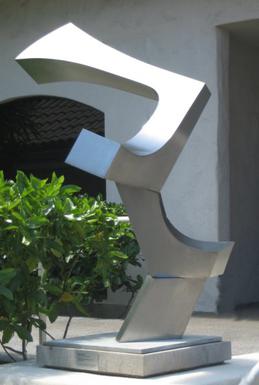
James Rosati was an American abstract sculptor. He is best known for creating an outdoor sculpture in New York: a stainless steel Ideogram.

Monument with Standing Beast is a sculpture by Jean Dubuffet previously located in front of the Helmut Jahn designed James R. Thompson Center in the Loop community area of Chicago, Illinois. Its location was across the street from Chicago City Hall to the South and diagonal across the street from the Daley Center to the southeast. It is a 29-foot (8.8 m) white fiberglass work of art. The piece is a 10-ton or 20,000 pounds (9,100 kg) work. It was unveiled on November 28, 1984.

Ugo Rondinone is a Swiss-born artist widely recognized for his mastery of several different media—most prominently sculpture, drawing and painting, but also photography, architecture, video and sound installation—in the largely figurative works he has made for exhibitions in galleries, museums and outdoor public spaces around the world. He has never limited himself to a particular material, no more than he has to a single discipline. Lead, wood, wax, bronze, stained glass, ink, paint, soil and stone are all tools in a creative arsenal that the artist has employed to extend the Romantic tradition in works that are as sensitive to the passage of time as to the nuances of body language and the spoken word.
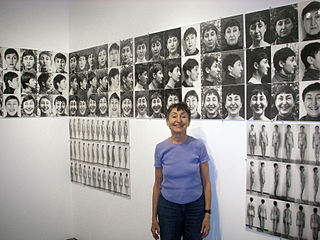
Athena Tacha, is a multimedia visual artist. She is best known for her work in the fields of environmental public sculpture and conceptual art. She also worked in a wide array of materials including stone, brick, steel, water, plants, and L.E.D. lighting. photography, film, and artists’ books. Tacha's work focused on personal narratives, and often plays with geometry and form.

Bernard J. Rosenthal, also known as Tony Rosenthal, was an American abstract sculptor widely known for his monumental public art sculptures, created over seven decades.

Atlas is a bronze statue in Rockefeller Center, within the International Building's courtyard, in Midtown Manhattan in New York City. It is across Fifth Avenue from St. Patrick's Cathedral. The sculpture depicts the ancient Greek Titan Atlas holding the heavens on his shoulders.

Spaces with Iron is a public sculpture by American artist Will Horwitt. It was installed in January 2009 on the Indiana University-Purdue University Indianapolis (IUPUI) campus, near downtown Indianapolis, Indiana. The sculpture is located at the corner of Blackford and Vermont Streets, on the southeast lawn of the Science Building, and is on long-term loan from the Indianapolis Museum of Art.
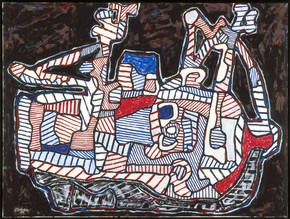
Courre Merlan (Whiting Chase) is an oil painting by French artist Jean Dubuffet. It has been part of the permanent collection of the Indianapolis Museum of Art since 1992.
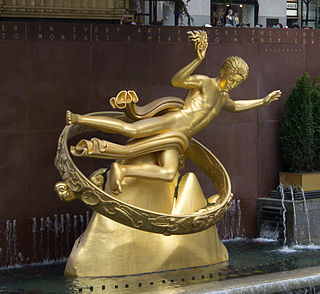
Prometheus is a 1934 gilded, cast bronze sculpture by Paul Manship, located above the lower plaza at Rockefeller Center in Manhattan, New York City.

Monument au Fantôme is an outdoor sculpture by French sculptor Jean Dubuffet, in 1977. It was originally inaugurated at the plaza of 1100 Louisiana. It is installed on Avenida de las Americas at Discovery Green in Houston, Texas, United States, since 2008. The painted fiberglass and steel frame sculpture features seven individual forms that represent features of Houston, including a chimney, church, dog, hedge, mast, phantom, and tree. Donated by the Dan Duncan family, it is part of Dubuffet's Hourloupe series, which has companion sculptures in Chicago, New York, and in Europe.

Three Piece Sculpture: Vertebrae is an abstract bronze sculpture by Henry Moore.
Slavko Kopač was a French painter, sculptor and poet.
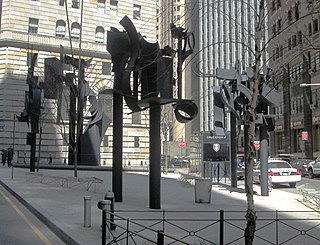
Louise Nevelson Plaza, is a public art installation and park in Lower Manhattan, New York City, which includes an arrangement of large abstract sculptures designed by the American 20th-century female artist Louise Nevelson. Described as an "outdoor environment", the triangle-shaped plaza is bounded by Maiden Lane, Liberty Street and William Street, adjacent to the building of the Federal Reserve Bank of New York.
Lee Bae is a South Korean visual artist who creates works in black.
Juliette Élisa Bataille was a French textile and outsider artist. She created small embroideries with the character of paintings, by sewing silk, cotton, and wool onto rectangular pieces of cardboard. She is known for the works she composed during a three-year period at Ville-Évrard Psychiatric Hospital. She met the artist Jean Dubuffet at the hospital, who was collecting art brut.
















